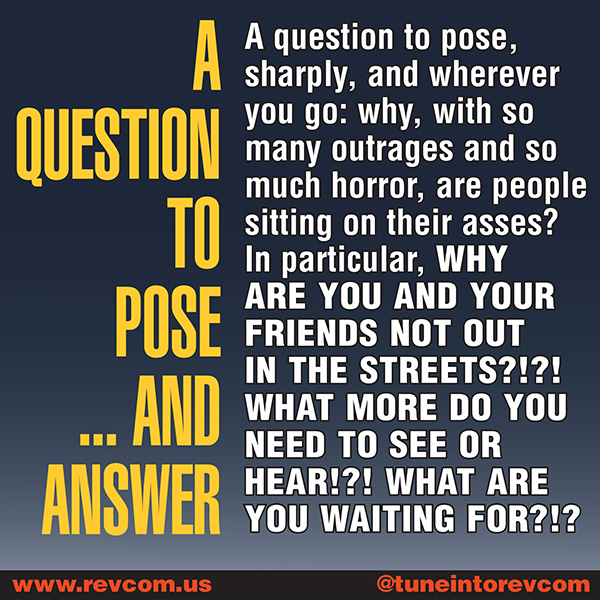Field notes from LA:
Taking the problems of the revolution out to the masses at the Lights for Liberty Vigil and Second Saturday in Highland Park
| revcom.us
“I really think lots of people WANT to talk about these types of questions/obstacles. These are objectively obstacles to revolution, even if they don’t quite see it that way yet because they are new. But communists wrangling with brand- new people (who care) over such questions (and how to get that geometric progression going) IS, objectively, ‘putting the problems of the revolution before the people’ and can also really help break down the ‘us/them divide.’ Communists leading this type of active social investigation are in an excellent position to at one and the same time learn a lot we ourselves need to know more about in terms of what holds people back, and actively transform the thinking of people through this very process. Lively and largely informal get-togethers to really wrangle over such questions and problems of these times can attract, inspire, and organizationally retain. We need to do a lot more of this!” (From Further Thoughts on Putting the Problems of the Revolution to the Masses).
On the weekend of the vigils and marches held around the country in response to the concentration camps on the border, we set out to disturb the rancid air of accommodation and to actively pose this problem to the people who do care about this to help solve it .
We went to a vigil in downtown LA and then to an Art Walk in a section of East LA that is a generations-old Chicano neighborhood, where young families and hipsters working in LA’s entertainment industry are now moving in.
We took the challenge that was printed as a meme in revcom: “A QUESTION TO POSE AND ANSWER: Why, with so many outrages and so much horror, are people sitting on their asses? In particular, why are you and your friends not out in the streets?” We also brought an announcement of a film showing of the speech by Bob Avakian: THE TRUMP/PENCE REGIME MUST GO! In the Name of Humanity, We REFUSE to Accept a Fascist America, A Better World Is Possible.
Asking this question was a challenge and an invitation to be part of figuring out how to change the situation that many people themselves recognize to be really very terrible. We found that people really WANT to engage these questions and that this often went deeper than engagement we’ve had before.
Opening Up Engagement and Controversy Over People’s Inaction in the Face of Fascism
At the Art Walk we became “what was happening” on the street, and people wanted to know “who are those people and what are they talking about.” There was a very rich, roiling scene for hours of people in groups of friends or family talking about the questions posed and the 5.2.6. Through all this, we learned a lot and got a firmer grasp on how posing the right questions IS part of leading a mass revolutionary process – where people new to the revolution and people who will never be revolutionary communists but who care and have important insights – are going to work with us to change the whole political terrain.
Some of What We Learned
When we put to people the question, “Do you think this vigil is going to stop what the regime is doing at the border?” it shook people out of thinking “at least I am showing up and I’m doing a good thing for my conscience” (both things that people said). It made people think about their responsibility to actually judge what is going on by the standard of what will it take to stop it.
Why are there not hundreds of thousands taking to the streets and stopping business as usual in the face of this? Many Jewish people we spoke with had a much better understanding that this is fascism. Two women talked about trying to get friends from work to protest, but they didn’t get the seriousness of what is happening. One referenced a book on 10 steps of fascism and said, “We are at #7 already but people are just living their lives, with all the pressures they feel. I have two kids and a job and no time but I have to do something. I know this isn’t much, but at least I’m showing up – people at work aren’t even paying attention.”
Quite a few people did not know, but were interested in, what was going on in Hong Kong, Algeria, and the Sudan. Not a unanimous sentiment but quite a few people said to us: “No one has called for that. If they did, I would come.”
One woman said she didn’t think that kind of mass protest would happen here because it’s not that bad yet. But as we talked, she began putting pieces together that she knew but really still hadn’t reckoned with. She’d say, “Oh, I guess that’s true” in response to the fact of concentration camps. When we said immigrants were being tortured, she first wondered if that was too harsh. But then being forced to look at the combination of things happening, she responded, “Oh, I guess that’s true.” She talked about how daily life is so all-consuming but that she still came to vigils and such because “we have to do something.” She seemed somewhat bewildered and then said, “I just have to think it’ll all work out somehow.” When I asked her what the basis for this was, she said she couldn’t really answer it.
At the end of the vigil, people exited where Refuse Fascism had a huge 50-foot banner that people were stopping to sign and donate to the #Freeway9. The Revolution Club was doing agitation on the 5-2-6 and people were grabbing up the leaflets and especially the younger angry people were stopping to get into the 5-2-6.
A grad student from UCLA was listening intently to the Revolution Club and said he’d been watching us on campus, “Everything you are saying is right.” He expressed frustration that he can get his friends to come to a party, but not to something like this. He couldn’t figure out why but he had ideas on how we could impact the campus better. He felt people don’t know what we are trying to do and when they hear the loud agitation they just “recoil and avoid it and shut you out when what you are saying needs to be heard.” We talked about how we are fighting to provoke people out of their stupor, why we stood on the flag at UCLA and how that kind of controversy is needed. He responded, “Yes, I saw that!” and agreed that we can’t just sit at a table like all the other clubs, we do have to stand out but we need a way to get people to stop and listen. He showed interest in helping to figure this out. He did not know about the examples of Hong Kong and elsewhere, but found this hopeful. Perhaps you could get people in this country to do this. Not just the activist clubs but the sororities and fraternities would have to be part of calling for something like that.
Getting Under People’s Skin and Inviting Them into a Process
We talked about his comments and felt we needed creative ways to get people to stop and not just walk past us at the Art Walk. So we went with big banners of the BEB (Bourgeois Electoral Bullshit) and You Can Not Reform the System/You have to Overthrow It, a full book table, and an orange crate. One of the Rev Club members dressed as the Grim-Reaper-Like Statue of Liberty with the meme. We experimented with agitation, at one point having someone imitate the liberal and the “It’s all going to be okay” tone of NPR radio. As people walked by, we’d say things like, “Legislation in seven states is being passed criminalizing civil disobedience and the right to protest, but don’t worry, you’re not using that anyway.” Or, “In breaking news, one million species will be extinct in 10 years, your grandchildren will never see a polar bear but humans will be ok... well, not the Bangladeshis. But they’re so far away and ice cream is much more pleasant in the warmer weather.” We’d break this up by posing, “Okay, on the real, people, what is it going to take to get you and your friends off your asses and into the streets to STOP all these outrages?”
Quite a few people stopped and tussled with why this is happening and how it could change. People who are agonizing stopped to talk both about the general problem and why they themselves were not doing what is needed. In the process of baring their hearts and examining what they were not doing, they also changed some of their thinking.
A few examples that highlight some patterns in discussions more generally:
- A couple in their late 30s talked about being occupied with work and raising two kids. The husband was more cynical, arguing that both the fascism and the passivity were just human nature and we’d never get American people to act. The wife talked about the fear of getting into the streets, the risk of violence from the police and arrest. She talked about how much work and kids and the daily grind takes over, that since they weren’t directly impacted, it was easy to look away. She wasn’t arguing this was right. On the contrary, she thought it was horrible. But still, she articulated how these different things all work to reinforce each other: the fear, your responsibility to your family (above all else), dealing with life, and you know about what’s happening to other people and you hate it but it’s too much to risk fully thinking about all of it and certainly acting to stop it. It’s easier to just hope that the Democrats will take care of this. We got a deeper sense of the coherence of the package that is keeping people so staid, even if they themselves recognize the moral bankruptcy of this.
- A guy in his 20s said firmly: I am doing something; I give all my time, energy, and resources to help under-resourced youths learn skills in film to tell their stories. He was passionate and clearly cared deeply. Without dismissing this, we put the problem back to him: as good as what he’s doing might be, how does he see the fact that all around him, fascism is consolidating? What will it take for him, and others, to confront that? He paused and said he could see the problem. He talked here about two things. First, people are picking their projects, plunging themselves into their work, and not taking in this larger problem. Second, people have fundamental assumptions about America. He was a rhetoric major in college and paid attention to how people talk and are trained to think about this country. People have this basic idea that America is a force for good and that’s hard to puncture. He didn’t know what it would take to break people out of this. He said we were making him uncomfortable, but that he “appreciated the challenge.”
- Most of the white middle class people who stopped mentioned not being impacted themselves as the reason why people are not acting. We had struggled with people on the moral bankruptcy of this, but in the future we need to be sharper and have them walk through how their inaction directly and catastrophically impacts others.
- Many people were so insulated in their own life and the mindless/endless brainwashing diversions on their phones that they did not even know what is going on at the border and more generally.
And probably the top two reasons people raised were:
- The rat race to keep a roof over your head and the pre-occupation (especially those who were better off) with your job and family. Some are consciously turning their heads away from things they tell themselves they cannot affect. But it is also the way people are fundamentally organized in this society, as individuals competing for jobs, housing, education for their children. For me and mine, be it desperate in the hood or living in million-dollar homes, the logic is the same. Putting their noses to the grindstone and the goal of consuming more, more, more and ignoring what is going on to other people’s families. This “American Dream” is humanity’s nightmare. This is an ideological “framework” that has to be blasted apart!
- The deceit – as well as the self-deceit – of the 2020 elections. All kinds of notions of incremental progress, taking the time that the right-wing forces did to build their base, electing women – all of which accept the myth that America is a flawed democracy that has historically been able to change for the better.
Someone who recently turned his head towards revolution reflected after seeing the Trump/Pence Must Go! speech by BA that he had always accepted that America is a Democracy that can change. Many still believe that and it makes you think that, while it may be really bad and could get even worse, eventually it will be rectified. You think you can wait it out. And at the same time people, and especially Black people, are very afraid of the government and what it might do. But he felt the main thing is that people do not know what to do. The solution is not out there enough for people – and that there is a serious revolutionary leader and people who are revolutionaries on this Tour who are real and ready to die for what they believe in.
We felt we still fell way short of the collective process that was possible and have ideas for how to do more of this on the spot. And we want to do much more with on-the-spot screenings of BA’s films and his Q&As. But we also felt this was an incredibly rich experience with real advances and important lessons we wanted to share right away.
Get a free email subscription to revcom.us:




